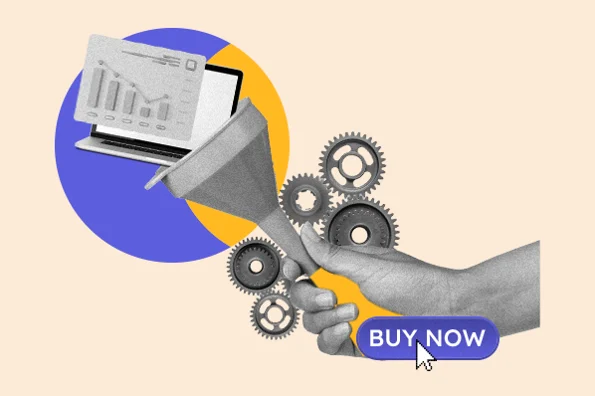Consultative Sales Process
A typical consultative sales process is made up of six stages. Each stage maps out winning behaviors and strategies. Here's an example:
- Stage 1: Target and Qualify
- Stage 2: Explore and Assess
- Stage 3: Access and Develop Solution
- Stage 4: Present Solution and Follow-up
- Stage 5: Negotiate and Close
- Stage 6: Implement, Follow Through, Assess Results, and Expand
The sales process stages should help guide salespeople in qualifying, closing, expanding business, and building relationships.
Each stage should define the objective, best practice activities, tools, models, and customer actions that signal readiness to advance to the next stage (for example, the customer agrees to a meeting in stage one or provides access to the executive buyer in stage two).
There should also be a list of sales coaching questions related to each stage. Some examples in Stage two would be: What business problem is the customer trying to solve? Have I reached the executive sponsor?
The stages must align with the buyer's journey: The process buyers go through to become aware of, evaluate, and purchase a new product or service.
Here's a typical buying cycle, along with the corresponding salesperson action.
Stage 1: Target and Qualify
The customer becomes aware of a business problem. Alternatively, the salesperson creates a pre-stage one opportunity by introducing an idea or challenge that is not yet on a customer’s agenda, or raises the visibility of an issue the customer has underestimated.
For example, a salesperson speaking with a company that offers online educational courses might say, "Some of your competitors have seen a decrease in online course subscribers as our economy has come out of the recession. Luckily, I've been able to help them find new avenues for attracting new business."
In this scenario, the salesperson identifies a problem, or a potential problem, the company or its industry is facing, and teases a solution.
Stage 2: Explore and Assess
Customers assess how much of a priority the issue is, determine their options, and develop decision criteria and decision process. Salespeople can help their prospects by sending them how-to blog posts, offering to run a consultative call, and sending them relevant content resources.
At this point, the salesperson would send case studies about how they've helped similar businesses overcome dwindling subscribers. They might also share relevant research or other articles that take a closer look at the state and future of online education.
And don't forget about video. Sending a helpful TED Talk or webinar is also a great way to grab a prospect's attention and provide valuable educational resources in an engaging manner.
Stage 3: Access and Develop Solution
Customers research, compare solutions, narrow down choices, and refine decision criteria. The salesperson must differentiate, focus on business outcomes, and prove value.
How will your solution differ from your competitor's? Make sure that's clear for your prospect. In our online education example, this might look like the following: "Many of our competitors offer to help you buy subscriber lists. We believe emailing thousands of people who have never signed up for your service is a bad customer experience. Instead, we help you target relevant subscribers at the right events, with the right ads, at the right time. This allows you to build a relationship instead of pitching your classes before your audience even knows who you are and how you can help them."
The salesperson has clearly outlined how they're different from others in their industry and the unique solution they offer for their prospect's business.
Stage 4: Present Solution and Follow Up
Knowledgeable customers make their selection and negotiate. Skilled salespeople will have already involved procurement prior to this stage. You should already know what steps need to be taken for your prospect's organization to buy a new product or service. That knowledge is crucial for presenting a solution with a realistic timeline.
Make sure you understand what the procurement process is and confirm that the solution you've laid out meets your champion's expectations.
For example, "I know that before I present to your executive team, your finance and paid advertising teams need to sign off on our solution. Do you think we will able to get their approval by the 14th of this month? And if so, would an executive presentation be realistic by the 20th?"
By securing your champion's agreement to the timeline, you have a more concrete plan forward, which makes follow up easier.
Step 5: Negotiate and Close
Customers make the purchase. Salespeople support implementation and follow-up. When a close is imminent, it's more important than ever to make sure your prospect feels supported.
You never want to lose a deal that's close to the finish line because you took attention off of nurturing a "done deal" and shifted it to a prospect higher in your funnel.
Check in with your late-stage prospects regularly. Ask if they have any questions or concerns. And get ahead of any red flags that might arise. If you touch base with a prospect who says, "My manager has approved the deal but is dragging her heals to sign the paperwork," ask if it would be appropriate for you to reach out directly to that stakeholder to answer questions or provide a gentle nudge.
Giving your champion prospect the backup they need is crucial at this stage.
Step 6: Implement, Follow Through, Assess Results, and Expand
Customers are in an evaluation mode. In the post-purchase stage, customers implement, measure outcomes, and evaluate performance against the sales promise. They decide on the future of the relationship. Salespeople must discuss results, prove value, and build on the rapport they previously created.
It is at the intersection of sales process and the buying process that sales are made. Marketing must step up to the plate and support the sales force not only with qualified leads but with knowledge sharing, research, and insights into industry and customer priorities, personas, and challenges. At that point, it is up to salespeople to build on that foundation to understand their customers on an individual, granular level to solve their business problems.
It has been my experience in building sales processes that almost all sales organizations have the fundamentals of an effective process within their reach -- but most don’t reach.
Defining a sales process doesn’t take significant blocks of time. To start, pull together a diverse team of sales leaders and top performers, operations, service, and marketing people to map out and capture elements such as key milestones in how customers buy, best practices, tools, customer actions, and models for each stage.
Consultative Salespeople
A consultative sales process is powerful because it clarifies for salespeople what is expected. Additionally, it guides sales managers in what to coach and evaluate.
A sales process, however, is not a silver bullet -- nor is it cast in stone. Instead, it's a map that detours and changes based on conditions. The sales process should also be flexible enough a salesperson can adapt it using their best judgment.
The success of a consultative sales process takes more than even the most clearly defined stages, models, and tools. What you won’t find laid out in the sales process are the salespeople tasked with carrying out the process, the sales managers committed to coaching to it, and sales leadership that fosters an open and supportive culture. These stand equal with process.
Just as customers’ buying patterns have dramatically changed, so too has what it takes to be a consultative salesperson. To execute, salespeople need a number of new skills and resources, including deeper knowledge, a higher level of skill, greater creativity to bring new perspectives and ideas to customers, better sales tools, and most importantly, committed sales leadership and coaching.
A new emphasis has been placed on sales process, but as essential and valuable as a consultative sales process is, success depends on the ability and dedication of sales leadership and the sales force to execute. In his book "Zen and the Art of Motorcycle Maintenance," Robert Pirsig makes a point worth remembering: The instruction book -- i.e., the process -- is only as good as the driver.





![Want to Create a Sales Plan? Let Me Show You How [+ 10 Sales Plan Examples]](https://53.fs1.hubspotusercontent-na1.net/hubfs/53/how-to-create-a-sales-plan-1.jpg)
![The Ultimate Sales Cheat Sheet Template to Help Boost Rep Success [New Data + Templates]](https://53.fs1.hubspotusercontent-na1.net/hubfs/53/ft-cheat.webp)
![How to use battle cards in your sales process [+ templates]](https://53.fs1.hubspotusercontent-na1.net/hubfs/53/%5BUse-Oct-08-2025-10-11-09-0787-PM.webp)



.jpg)
